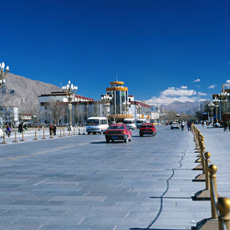
Lhasa, the capital city of the Tibet Autonomous Region is a place where most travelers start their Tibet-trip since it is easier and more convenient to reach.
The city sits at an altitude of 3,650 meters and has a history for more than 1,300 years.
As 300 days out of 365 enjoy sunlight, Lhasa is referred to the "Sunshine City" and it is dry in most months.
The Potala Palace is regarded as the symbol of Tibet and no doubt the most famous structure in Lhasa.
The construction of the Potala Palace was started in the year 631, when the power of the Tubo Kingdom (633-877) reached its peak. The king Srontsan Gampo decided to build this gorgeous palace in order to welcome his bride, Princess Wen Cheng of the Tang Dynasty (618-907).
The Potala Palace is 110 meters in height with more than 1,000 rooms, and the statues of the Tubo King Srongtsan Gampo and his wife are still worshipped in the palace.
Barkhor Street, a circular street at the center of Old Lhasa, is the oldest street in Tibet, and a must-see.
Barkhor is the road by which pilgrims visited Jokhang Temple throughout the centuries. Buddhist pilgrims walk or prostrate themselves and progress by body-lengths along the street clockwise every day into the deep night. Most of Lhasa's transient population is comprised of these pilgrims. The pilgrims walk around four columns on which colorful streamers printed with scriptures are hung, a custom which began in the Tubo period as a way to show respect.
The street is also a marketplace where shaggy nomads, traders, robed monks and chanting pilgrims join together.
Namtso Lake is the highest saltwater lake in the world and the second-largest saltwater lake in China. Meaning Heavenly Lake in Tibetan, Namtso is respected as one of the three holiest lakes by Buddhist pilgrims. Thousands of pilgrims from every corner of Tibet cluster to Namtso after long and hard treks.
The Jokhang Temple, located at the center of Lhasa, displays the most splendid Tubo-period architecture in Tibet. It is also one of the oldest wooden buildings in Tibet.
For more than 1,000 years, the Jokhang Temple has remained the favorite spot for worshippers from near and far.
Other attractions include Drepung Monastery, Norbulinka Monastery, Ganden Monastery and Sera Monastery.
Travel tips
When to go: The best time of year to be in Tibet is between May and early November, after which temperatures start to plummet. Lhasa and Shigatse experience very mild weather between May and November although July and August can be rainy. These two months usually see around half of Tibet's annual rainfall.
Getting there: Flying from Chengdu (capital city of Sichuan Province) will be most convenient, as more than one flight leave Chengdu for Lhasa every day. In addition, other big cities such as Beijing, Shanghai and Guangzhou also have direct flights to Lhasa.
There are long-distance buses to Lhasa from Chengdu, Lanzhou (Gansu Province), Ge'ermu and Xining (Qinghai Province).
Visa: Foreign visitors, in addition to a normal Chinese visa, must hold an Alien Travel Permit, issued by the Tibet Tourism Bureau (TTB).
Warning: People who suffer from high blood pressure or heart disease cannot travel to Tibet because of the high altitude stress.
How to prevent acute mountain sickness:
●Drink extra fluids. The dry air and evaporation of sweat may cause dehydration.
●Avoid alcohol as it may increase the risk of dehydration, and don't smoke.
●Avoid sedatives.
●Avoid catching cold before entering Tibet.
(Shenzhen Daily September 30, 2005)
|

